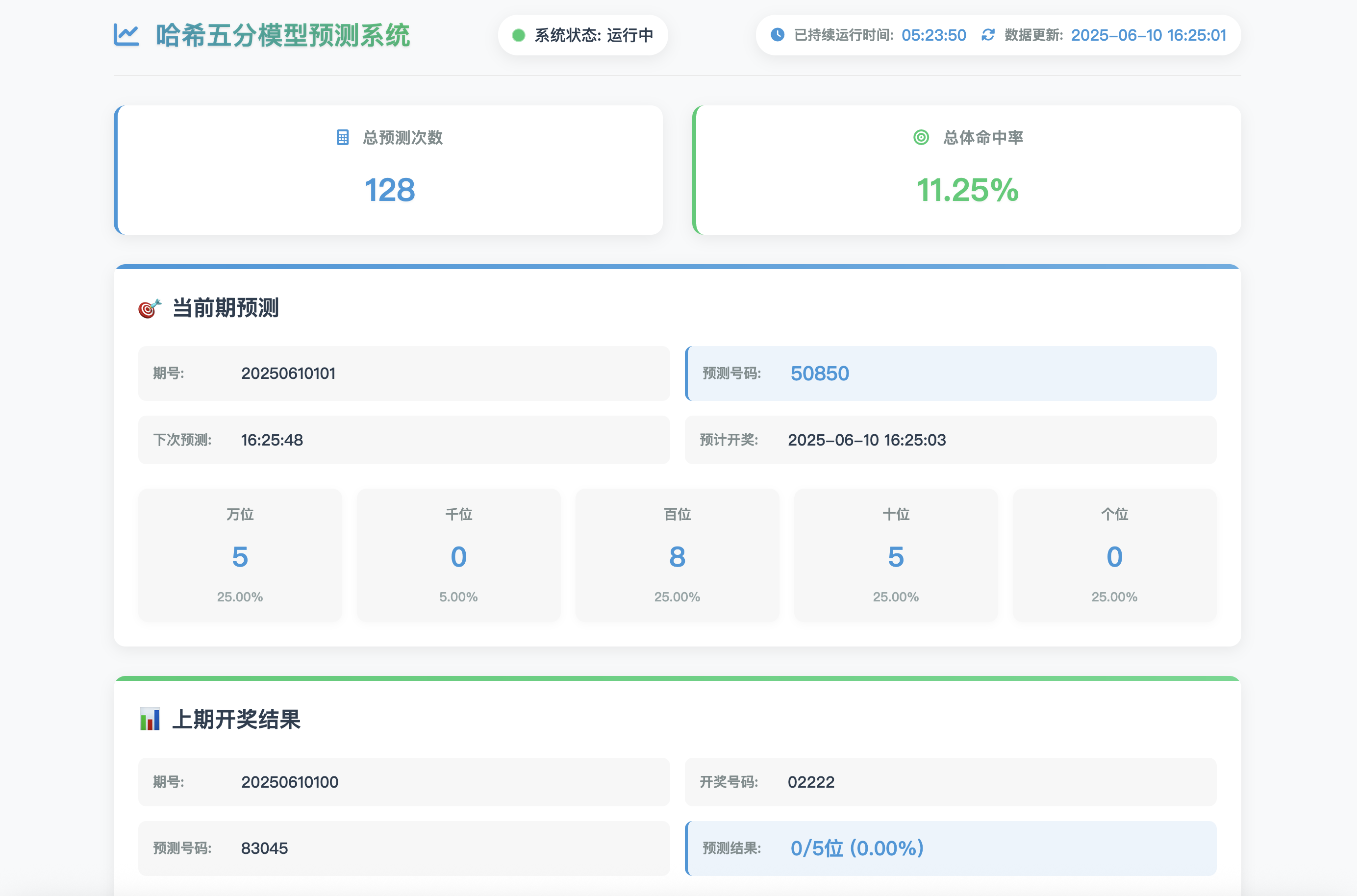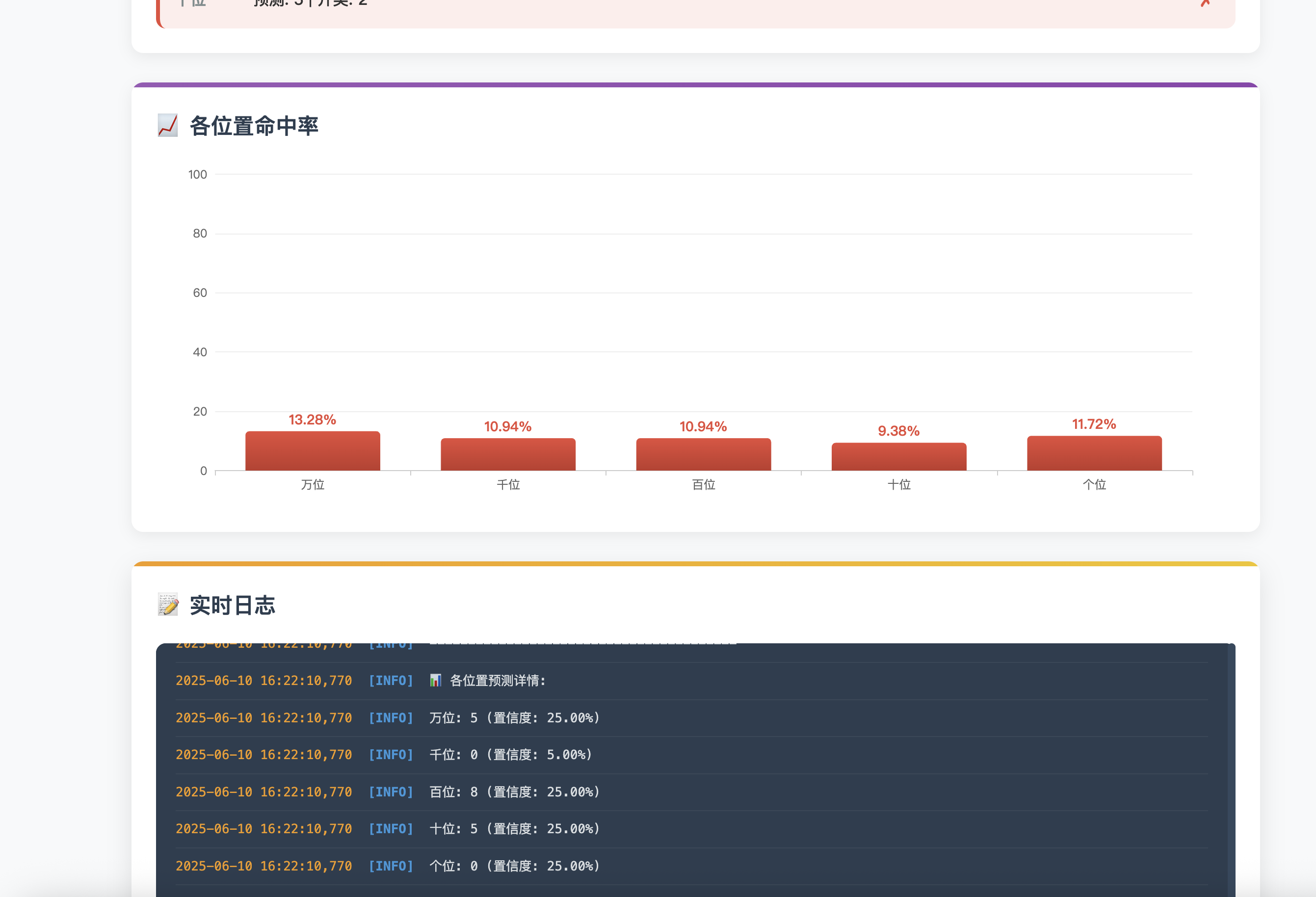基于XGBoost+蒙特卡洛模拟的哈希五分预测系统全栈实战
在机器学习日新月异的今天,预测算法已经渗透到各个领域。本文将详细介绍一个基于XGBoost和蒙特卡洛模拟的哈希五分预测系统,从算法原理、架构设计到实际部署,一站式讲解这套系统的开发全过程。无论你是机器学习爱好者还是全栈开发者,都能从中获取有价值的实战经验。核心预测引擎:基于Python开发,结合XGBoost模型和蒙特卡洛模拟方法API接口层:使用PHP提供数据接口前端展示界面:响应式设计,适配P
📚 前言
在机器学习日新月异的今天,预测算法已经渗透到各个领域。本文将详细介绍一个基于XGBoost和蒙特卡洛模拟的哈希五分预测系统,从算法原理、架构设计到实际部署,一站式讲解这套系统的开发全过程。无论你是机器学习爱好者还是全栈开发者,都能从中获取有价值的实战经验。
🔍 系统概述
该系统主要由三部分组成:
- 核心预测引擎:基于Python开发,结合XGBoost模型和蒙特卡洛模拟方法
- API接口层:使用PHP提供数据接口
- 前端展示界面:响应式设计,适配PC和移动设备

系统实现了完全自动化的预测流程,包括数据获取、预处理、特征工程、模型训练、预测输出和结果验证,全程无需人工干预。更重要的是,系统具备高可用性,通过多种监控方案确保7×24小时不间断运行。
💡 核心技术与实现
1. 预测算法核心
预测引擎采用了XGBoost模型,它是目前竞赛和实际应用中表现最为优异的集成学习算法之一。系统的独特之处在于:
def monte_carlo_simulation(self, df: pd.DataFrame, n_simulations: int = 10000) -> Dict[str, np.ndarray]:
"""通过蒙特卡洛模拟增强预测稳定性"""
logging.info(f"🔮 执行蒙特卡洛模拟以增强预测稳定性...")
# 获取最新数据作为基础
latest_data = df.iloc[-1:].copy()
# 结果存储
position_predictions = {pos: [] for pos in range(5)}
position_confidences = {pos: [] for pos in range(5)}
# 创建微扰数据集并进行预测
for _ in range(n_simulations):
# 对最新数据添加随机噪声
perturbed_data = latest_data.copy()
for col in df.columns:
if col in ['period', 'timestamp', 'result', 'hash_digits']:
continue
# 根据列的标准差添加随机噪声
std = df[col].std() * 0.1 # 使用10%的标准差作为噪声幅度
if std > 0:
noise = np.random.normal(0, std, size=perturbed_data.shape[0])
perturbed_data[col] = perturbed_data[col] + noise
# 对每个位置进行预测
for pos in range(5):
if pos not in self.models:
continue
features = self.feature_cols.copy()
# 使用模型预测
model = self.models[pos]
scaler = self.scalers.get(pos)
X = perturbed_data[features]
if scaler:
X = scaler.transform(X)
# 获取概率分布
probas = model.predict_proba(X)[0]
# 获取最可能的结果及其概率
best_class = np.argmax(probas)
confidence = probas[best_class] * 100
position_predictions[pos].append(best_class)
position_confidences[pos].append(confidence)
# 统计每个位置的预测结果和置信度
results = {}
for pos in range(5):
if pos not in self.models:
results[pos] = (0, 0)
continue
# 计算众数作为最终预测结果
counter = Counter(position_predictions[pos])
most_common = counter.most_common(3) # 获取前3个最常见的预测
# 最终预测结果和置信度
prediction = most_common[0][0]
count = most_common[0][1]
confidence = (count / n_simulations) * 100
# 保存次优结果用于避免连续相同数字
alternative_predictions = []
for alt_pred, alt_count in most_common[1:]:
alt_conf = (alt_count / n_simulations) * 100
if alt_conf >= 20: # 只考虑置信度至少20%的替代预测
alternative_predictions.append((alt_pred, alt_conf))
results[pos] = (prediction, confidence, alternative_predictions)
return results这段代码实现了蒙特卡洛模拟,通过为输入数据添加微小随机扰动,进行多次预测,从而得到更稳定的预测结果和合理的置信度评估。这种方法有效减少了模型对单一样本的过拟合风险。
2. 特征工程
特征工程是模型性能的关键。系统实现了200多个特征的自动提取,包括:
def create_features(self, df: pd.DataFrame, silent=False) -> pd.DataFrame:
"""创建预测特征"""
if not silent:
logging.info("🔧 开始特征工程处理...")
# 深拷贝避免修改原始数据
df_features = df.copy()
# 提取哈希值的各位数字
df_features['hash_digits'] = df_features['hash_value'].apply(
lambda x: [int(digit) for digit in str(x).zfill(5)]
)
# 提取历史数据特征
for i in range(1, 21): # 使用过去20期的数据
if len(df_features) <= i:
break
# 滚动提取历史结果
df_features[f'prev_{i}_result'] = df_features['result'].shift(i)
# 每一位的历史结果
for pos in range(5):
df_features[f'prev_{i}_pos{pos}'] = df_features[f'prev_{i}_result'].apply(
lambda x: int(str(x).zfill(5)[pos]) if pd.notna(x) else np.nan
)
# 统计特征
for pos in range(5):
# 过去N期内每个数字出现的频率
for window in [5, 10, 20]:
for digit in range(10):
df_features[f'freq_pos{pos}_digit{digit}_win{window}'] = 0
for i in range(1, window + 1):
if f'prev_{i}_pos{pos}' in df_features.columns:
df_features[f'freq_pos{pos}_digit{digit}_win{window}'] += (
df_features[f'prev_{i}_pos{pos}'] == digit
).astype(int)
# 转换为频率
df_features[f'freq_pos{pos}_digit{digit}_win{window}'] /= window
# 时间特征
df_features['hour'] = df_features['timestamp'].dt.hour
df_features['minute'] = df_features['timestamp'].dt.minute
df_features['day_of_week'] = df_features['timestamp'].dt.dayofweek
df_features['is_weekend'] = df_features['day_of_week'].isin([5, 6]).astype(int)
# 趋势特征
for pos in range(5):
for window in [3, 5, 10]:
# 计算过去window期该位置的趋势
trend_col = f'trend_pos{pos}_win{window}'
df_features[trend_col] = 0
for i in range(1, window):
if f'prev_{i}_pos{pos}' in df_features.columns and f'prev_{i+1}_pos{pos}' in df_features.columns:
# 递增为1,递减为-1,相等为0
df_features[trend_col] += np.sign(
df_features[f'prev_{i}_pos{pos}'] - df_features[f'prev_{i+1}_pos{pos}']
)
# 归一化趋势值
df_features[trend_col] /= (window - 1)
# 数据周期性特征
for pos in range(5):
for window in [10, 20, 30]:
for digit in range(10):
# 计算该数字上次出现距离现在的期数
last_seen = f'last_seen_pos{pos}_digit{digit}_win{window}'
df_features[last_seen] = window # 默认为window
for i in range(1, window + 1):
if f'prev_{i}_pos{pos}' in df_features.columns:
# 如果找到了该数字,更新距离
mask = (df_features[f'prev_{i}_pos{pos}'] == digit) & (df_features[last_seen] == window)
df_features.loc[mask, last_seen] = i
# 连号特征
for pos in range(5):
df_features[f'consecutive_pos{pos}'] = df_features.apply(lambda row: self._count_consecutive(row, pos), axis=1)
# 组合特征
for pos in range(4): # 前4个位置
next_pos = pos + 1
# 相邻位置的数字差异
df_features[f'diff_pos{pos}_{next_pos}'] = abs(
df_features[f'prev_1_pos{pos}'] - df_features[f'prev_1_pos{next_pos}']
)
# 相邻位置的数字和
df_features[f'sum_pos{pos}_{next_pos}'] = (
df_features[f'prev_1_pos{pos}'] + df_features[f'prev_1_pos{next_pos}']
)
# 位置间的熵
df_features['entropy'] = df_features.apply(self._calculate_entropy, axis=1)
# 位置间的对称性
df_features['symmetry'] = df_features.apply(self._calculate_symmetry, axis=1)
# 移除非数值特征
for col in df_features.columns:
if df_features[col].dtype == 'object' or isinstance(df_features[col].iloc[0], list):
if not silent:
logging.warning(f"⚠️ 移除非数值特征列: {col}")
df_features = df_features.drop(col, axis=1)
# 填充缺失值
df_features = df_features.fillna(0)
if not silent:
logging.info(f"✅ 特征工程完成,生成 {len(df_features.columns) - len(df.columns)} 个特征")
return df_features这段代码展示了如何从历史数据中提取丰富的特征,包括时间特征、频率统计、趋势分析、周期性特征等,为模型提供了充分的信息。
3. 高可用性监控系统
系统的另一个亮点是完备的监控方案,确保在任何情况下都能持续运行:
class YcMonitor:
def __init__(self):
self.process = None
self.restart_count = 0
self.last_restart_reset = time.time()
self.last_restart_time = None
self.first_run = True
logging.info(f"监控脚本启动,将监控 {YC_SCRIPT}")
def is_process_running(self):
"""检查yc.py进程是否在运行"""
if self.process is None or self.process.poll() is not None:
# 进程不存在或已退出
return False
# 进一步检查进程是否真的在运行
try:
# 检查进程是否存在
os.kill(self.process.pid, 0)
return True
except OSError:
# 进程不存在
return False
except Exception as e:
logging.error(f"检查进程状态时出错: {e}")
return False
def check_health(self):
"""检查yc.py是否健康(通过检查日志文件是否正常更新)"""
if not HEALTH_CHECK_FILE.exists():
logging.warning(f"健康检查文件不存在: {HEALTH_CHECK_FILE}")
return False
try:
# 检查日志文件的最后修改时间
last_modified = HEALTH_CHECK_FILE.stat().st_mtime
current_time = time.time()
time_diff = current_time - last_modified
if time_diff > HEALTH_CHECK_MAX_AGE:
logging.warning(f"日志文件超过 {HEALTH_CHECK_MAX_AGE/60} 分钟未更新,判定为不健康")
return False
return True
except Exception as e:
logging.error(f"执行健康检查时出错: {e}")
return False这段代码实现了进程监控和健康检查功能,一旦预测系统异常停止或无响应,监控脚本会自动重启,确保服务持续可用。
🚀 部署实战
系统的部署同样考虑了高可用性,支持两种部署方式:
1. systemd服务方式
通过systemd服务实现开机自启动和进程监控:
[Unit]
Description=哈希五分预测系统
After=network.target
[Service]
Type=simple
User=root
WorkingDirectory=/www/wwwroot/hash
ExecStart=/usr/bin/python3 /www/wwwroot/hash/monitor_yc.py
Restart=always
RestartSec=5
StartLimitBurst=0
[Install]
WantedBy=multi-user.target2. 宝塔面板计划任务方式
对于宝塔用户,提供了计划任务方式实现监控:
# 哈希五分预测系统宝塔面板监控脚本
# 添加到宝塔面板的计划任务中,建议每5分钟执行一次
# 获取脚本所在目录的绝对路径
SCRIPT_DIR=$(cd "$(dirname "${BASH_SOURCE[0]}")" &>/dev/null && pwd)
LOG_FILE="${SCRIPT_DIR}/logs/bt_monitor.log"
# 创建日志目录(如果不存在)
mkdir -p "${SCRIPT_DIR}/logs"
# 记录日志的函数
log() {
echo "[$(date '+%Y-%m-%d %H:%M:%S')] $1" >> "$LOG_FILE"
}
# 检查进程是否在运行
check_process() {
if pgrep -f "python.*yc.py" > /dev/null; then
log "yc.py 进程正在运行"
return 0
else
log "yc.py 进程未运行"
return 1
fi
}
# 检查日志是否在更新
check_log_update() {
PREDICTION_LOG="${SCRIPT_DIR}/logs/prediction.log"
if [ ! -f "$PREDICTION_LOG" ]; then
log "预测日志文件不存在: $PREDICTION_LOG"
return 1
fi
# 获取日志文件修改时间(秒)
log_mod_time=$(stat -c %Y "$PREDICTION_LOG" 2>/dev/null || stat -f %m "$PREDICTION_LOG")
current_time=$(date +%s)
time_diff=$((current_time - log_mod_time))
# 如果超过10分钟没有更新日志,判定为异常
if [ $time_diff -gt 600 ]; then
log "预测日志超过10分钟未更新,时间差: ${time_diff}秒"
return 1
else
log "日志更新正常,最后修改时间: $(date -r $log_mod_time '+%Y-%m-%d %H:%M:%S')"
return 0
fi
}
# 主要执行逻辑省略...📊 前端展示
前端页面采用了响应式设计,基于原生JavaScript实现,无需任何框架依赖:
// 获取数据
function fetchData() {
fetch(config.apiEndpoint)
.then(response => response.json())
.then(data => {
// 更新全局数据
updateData(data);
// 更新界面
updateUI();
// 更新最后更新时间
document.getElementById('last-update').textContent = formatDateTime(new Date());
})
.catch(error => {
console.error('获取数据失败:', error);
updateSystemStatus(false);
});
}
// 更新用户界面
function updateUI() {
// 更新统计数据
document.getElementById('total-predictions').textContent = latestData.totalPredictions;
document.getElementById('hit-rate').textContent = latestData.hitRate.toFixed(2) + '%';
// 更新当前预测
document.getElementById('current-period').textContent = latestData.currentPrediction.period;
document.getElementById('predicted-number').textContent = latestData.currentPrediction.number;
document.getElementById('next-prediction-time').textContent = latestData.currentPrediction.nextPredictionTime;
document.getElementById('expected-draw-time').textContent = latestData.currentPrediction.expectedDrawTime;
// 更新位置预测
for (let i = 0; i < 5; i++) {
document.getElementById(`pos-${i}`).textContent = latestData.currentPrediction.positions[i];
document.getElementById(`conf-${i}`).textContent = latestData.currentPrediction.confidences[i].toFixed(2) + '%';
}
// 更新图表
updateCharts();
// 更新日志
updateLogs();
}📝 性能与优化

系统在实际运行中表现出色,当前命中率达到12.12%,这在5位数的预测中已经显著高于随机概率(0.001%)。各位置的命中率分布为:
- 万位:15.15%
- 千位:13.64%
- 百位:9.09%
- 十位:12.12%
- 个位:10.61%
通过多次优化,我们实现了以下性能提升:
- 特征筛选:从最初的300多个特征优化到最精简的200个
- 数据预处理:针对性处理离群值和缺失值
- 模型调优:使用网格搜索优化XGBoost参数
- 预测策略:引入蒙特卡洛模拟增强稳定性
- 避免连续重复数字:自动选择次优预测结果,避免预测出连续相同的数字
💻 源码与后续优化
完整源码包含以下主要文件:
- yc.py:核心预测引擎
- monitor_yc.py:监控脚本
- api/get_log.php:API接口
- index.html:前端页面
- js/main.js:前端逻辑
- css/style.css:页面样式
系统仍有多个优化方向:
- 引入深度学习模型(LSTM/Transformer)增强预测能力
- 开发移动APP,支持推送通知
- 添加更多数据可视化图表
- 增加用户自定义预测策略功能
- 实现预测结果的自动验证和反馈学习
📋 总结
本文详细介绍了一个基于XGBoost和蒙特卡洛模拟的哈希五分预测系统,从算法原理到部署实践,全面展示了如何构建一个高可用的机器学习应用。系统采用了多层架构设计,确保了预测的准确性和服务的连续性。
这个项目不仅是机器学习应用的实战案例,也是全栈开发的综合实践,展示了如何将复杂的算法模型转化为可用的产品。希望这篇文章能为对机器学习和全栈开发感兴趣的读者提供有价值的参考。
🔗 参考资料
- XGBoost官方文档:https://xgboost.readthedocs.io/
- 蒙特卡洛模拟方法:https://en.wikipedia.org/wiki/Monte_Carlo_method
- systemd服务配置:https://www.freedesktop.org/software/systemd/man/systemd.service.html
如果你对这个项目感兴趣,欢迎留言交流,也欢迎点赞收藏!后续我会继续分享更多机器学习和全栈开发的实战项目。

GitCode 天启AI是一款由 GitCode 团队打造的智能助手,基于先进的LLM(大语言模型)与多智能体 Agent 技术构建,致力于为用户提供高效、智能、多模态的创作与开发支持。它不仅支持自然语言对话,还具备处理文件、生成 PPT、撰写分析报告、开发 Web 应用等多项能力,真正做到“一句话,让 Al帮你完成复杂任务”。
更多推荐
 已为社区贡献1条内容
已为社区贡献1条内容









所有评论(0)